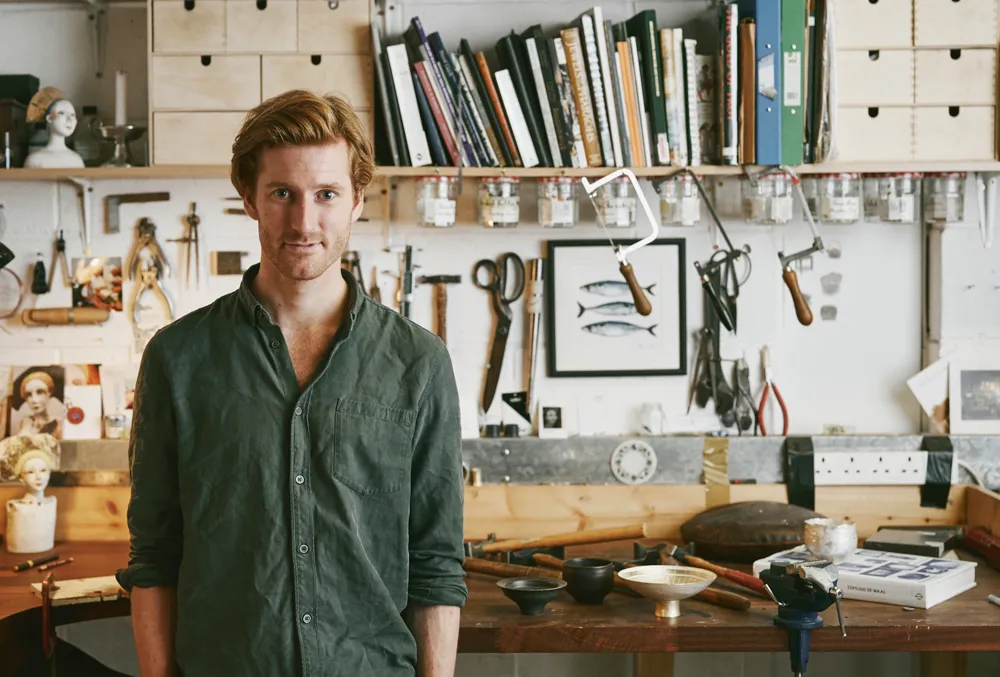Samuel Waterhouse happened upon his love of silversmithing while studying English Literature at university in Manchester. He made his first piece of jewellery, a simple silver bangle, for his girlfriend at the time and there began his love of crafting silver. Now, from his Sheffield-based workshop, Samuel creates exquisite handmade silverware that is the epitome of high-quality design.

What drew you to silversmithing?
I had never worked in any metal before I started working in silver. My dad gave me a vice, some tools and taught me how to solder – the rest I learned through books and experimentation. I liked the idea that I was making something for my girlfriend and thinking she might like it. I used to rent a bench from a jeweller in Manchester and every Wednesday I would work there to develop my skills. If
I had left university without having done that, I doubt I would have had the confidence to try and pursue silverwork as a career.
It’s something about the simplicity of ancient art and antiquities that’s so wonderful.
What inspires your designs?
Anything from antiquity – in particular ceramics and ancient art. It’s something about the simplicity of these subjects that’s so wonderful. I also love 20th-century ceramicists like Lucie Rie – she too was influenced by ancient art.

Do you take inspiration from other makers?
Definitely. When you are at a show like the Goldsmiths’ Fair, you are exposed to other makers and subconsciously you are influenced by them. For about four years straight after finishing university, I took a space in a workshop in London’s Walthamstow and just being exposed to other people’s way of working was massively influential. Not really in terms of style but more so in terms of quality and their discipline and attitude towards making – it’s wonderfully infectious.
Broadly, what is your process?
Every single piece I make seems to inform the next. The starting point is not a blank piece of paper, but the history of what I have made previously. It’s not really a consciousdecision to design something– it just slowly forms over time. I do live in a state of worry that it is just going to stop happening eventually! When making a bowl, I like to form the piece as a ceramic first to get the shape right, and develop it from there. When working with silver, I start with a circular disc of metal, which I hammer into shape. I use a Korean technique called Keum-boo, which translates as ‘attach gold’. Traditionally, Keum-boo is the fusion of pure gold to fine silver, however I have altered the technique slightly so that I can use various different colours of gold, such as white and green.

What has been the proudest moment of your career so far?
I had a really nice experience at the last Goldsmiths’ Fair (September 2019) where one of my pieces was bought by Goldsmiths to be a part of its collection. The year before that I was asked by Goldsmiths to make some work for its gallery stand at the Collect international art fair.
How has Goldsmiths supported you?
It’s what it is and what it provides – its reputation for quality and excellence. My whole year is based around my application to the Fair. I feel like it creates a state of mind that’s driven towards Goldsmiths’ high standards.

What are your plans for the future?
My really long-term plan is to one day have a space for makers that is renowned for top-quality pieces. I would love to create a place where artisans would be proud to craft. For now though, I want to continue to develop my own work – that is the most important thing to me at the moment.
You can see more of Samuel Waterhouse’s beautiful work at samuelwaterhouse.co.uk
Photography: Jesse Wild
